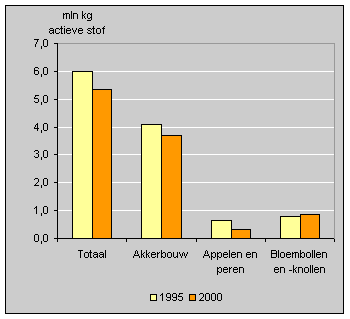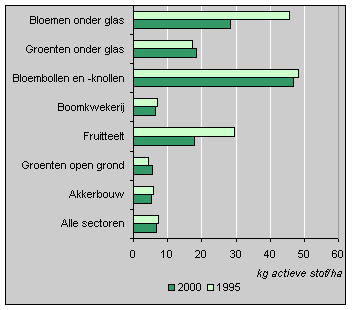Less chemical pesticide used in agriculture

Between 1995 and 2000, farmers and horticulturists in the Netherlands cut the use of chemical pesticides from 6.0 million kg to 5.3 million kg, a ten percent decrease. The reduction is mainly attributable to a decrease in the amount applied per hectare. Arable farmers and market gardeners used 6.6 kg of active matter per hectare in 2000. In 1995 it was more than ten percent higher at 7.4 kg.
Use of chemical pesticides

Arable farmers and fruit growers use less
The most substantial decrease between 1995 and 2000 was in arable and fruit farming. Arable farmers account for seventy percent of total pesticides. Use of fewer pesticides on green maize accounted for half of the decrease in the arable sector. The reduction in pesticides applied to potato crops (43 percent of pesticides in arable farming), accounted for 37 percent of the total reduction.
In the fruit sector, much less fungicide was used by apple and pear growers.
Chemical pesticides per ha

More used in flower bulb and corm growing
There was an increase in pesticides used for flower bulbs and corms and for vegetables in the open.
The rise in the total use of pesticides by flower bulb and corm growers was mainly caused by the expansion of the area used to cultivate lilies. The cultivation of lilies requires a lot of pesticide per hectare. This is the reason that despite all efforts to reduce pesticide use in this sector, bulb growers have been the largest category of users for years now. The use per hectare in the cultivation of vegetables in the open was primarily pushed up in the period 1995 to 2000 by a sharp rise in application per hectare for sprouts.
Use of some pesticide groups

Insecticides, fungicides and herbicides
The use of insecticides halved between 1995 and 2000, that of herbicides fell by about 16 percent. An important part of this decrease was caused by the introduction of new methods, which involve less active matter. For weeds, the increasing use of mechanical equipment also played a part. The use of fungicides has risen slightly, however.
Tom Loorij